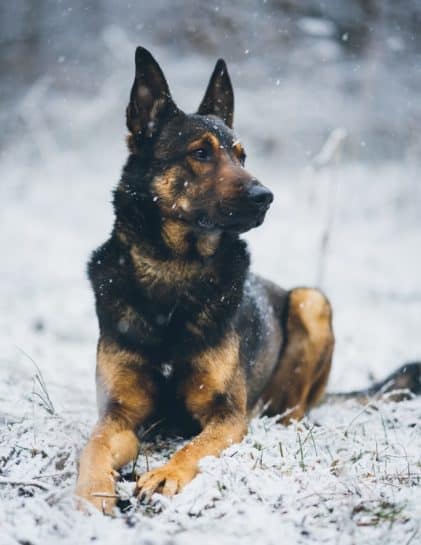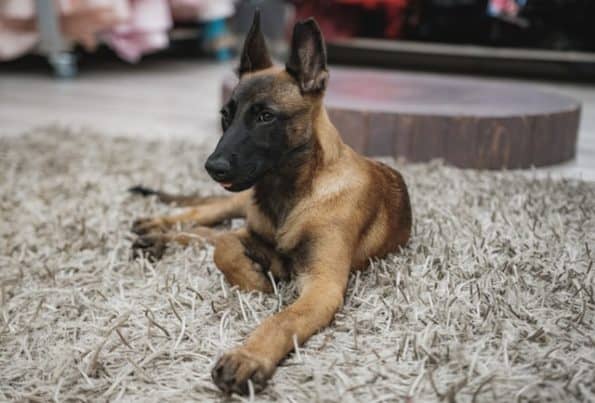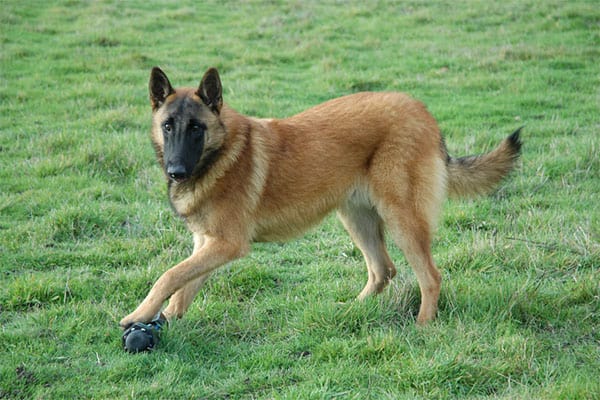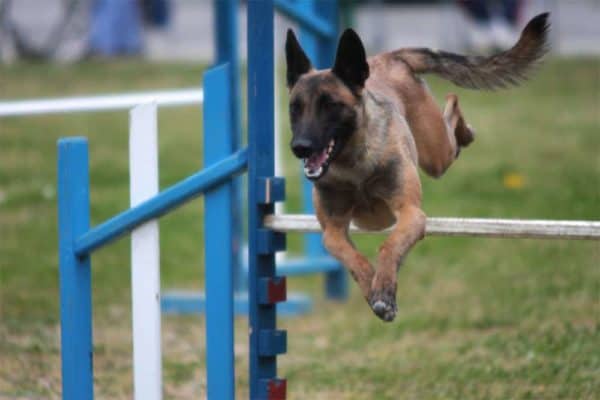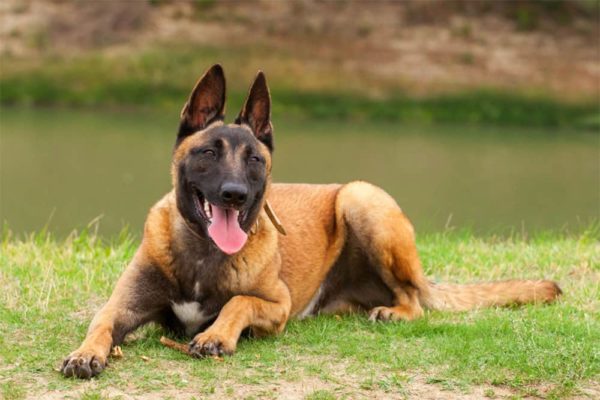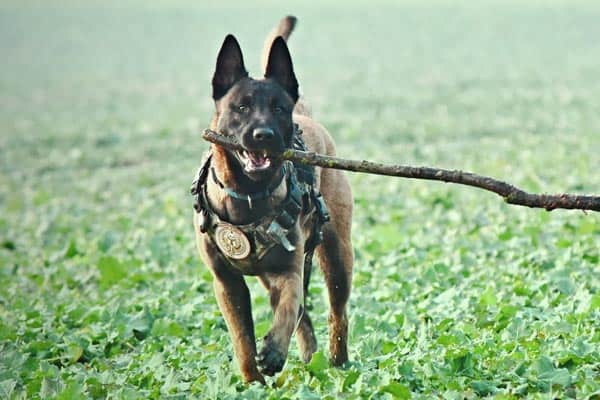Belgian Malinois Training: Why These Working Dogs Need Specialized K-9 Training
A Belgian Malinois is a top pick worldwide for K-9 military, police, and security jobs. These dogs are unmatched in protecting and guarding roles.
But they do not tend to make very good pets unless you give them special training and several hours per day of high-intensity activity, exercise, and play.
To put this in perspective, some top K-9 trainers make up to $100,000 just to train a single Belgian Malinois!
In this article, learn about what kind of training the Belgian Malinois dog needs to be a good family companion and protection dog.
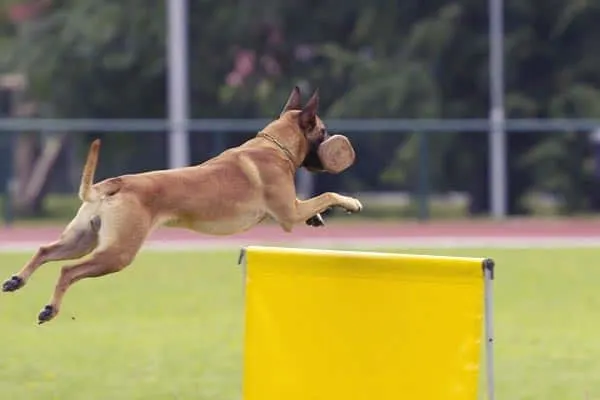
Belgian Malinois Training
The Belgian Malinois dog needs two kinds of training.
The first kind of training is the kind every dog needs. Belgian Malinois puppies need to learn the basic commands just like all puppies do.
The second kind of training is specialized for protection and guard dog breeds. Your Malinois needs to learn how to distinguish between friends and potential threats and only special protection dog training can teach that.
Learn About Why the Belgian Malinois Needs Special Handling
In this YouTube video, a Belgian Malinois owner gets real about what this high-energy, all-work, no “off” button dogs need to cope with any life that doesn’t include a full-time job.
As the owner points out, it doesn’t matter if you are sick, late home from work, dealing with an unexpected emergency, or just tired. Your Malinois will find something to do and that something is likely to be intensely problematic and destructive.
This is not the dog’s fault. It is just how these dogs are wired. They have been bred to be exactly this way, so it is important to be prepared for that before making a commitment to a Belgian Malinois dog.
Understand the Belgian Malinois Breed History
The American Kennel Club (AKC) states that Belgian Malinois female adult dogs may weigh 40 to 60 pounds and stand 22 to 24 inches tall. Male adult Mals can weigh 60 to 80 pounds and stand 24 to 26 inches tall.
So the Belgian Malinois is not an enormous dog like a Mastiff or a Great Dane. These dogs don’t intimidate with sheer size.
The greater truth is, they don’t have to use their size. They have many other gifts. The Belgian Malinois is one of the top K-9 athletes in the world. Their lean, rangy frame and long legs are a huge asset in their job as protection and guard dogs.
No other dog can climb sheer walls and swim and run flat out and restrain a threat the way a well-trained working Malinois can.
But a big part of the reason for this is that this is what Malinois dogs have been bred to do for generations.
The American Belgian Malinois Club explains that the Malinois is actually one of four closely related Belgian Shepherd (or herding) dog breeds.
The other three breeds are the Tervuren, the Laekenois, and the Groenendael – each named for the area in Belgium where the breeds were developed.
All four dogs have very high herding, guarding, protecting, and prey drive. They live to herd and chase and maintain constant vigilance over their charges, which at first were sheep and later became people.
What is most important to understand about the Belgian Malinois dog’s history is that these have never ever been “pet” dogs. They have always worked hard at a difficult job on a daily basis, day in, and day out.
It is true that they live and work alongside people, but Malinois also has a very independent job to do, which can make them even more difficult to train because they won’t intuitively understand the need for commands like “stay” or “drop it.”
Getting Started on the Right Foot with Belgian Malinois Training
As the American Kennel Club explains, most people who buy a Belgian Malinois want a family guarding and protection dog.
This is an admirable goal and a valid one.
However, most first-time Malinois owners simply do not know enough about the breed itself to understand what they are getting themselves into!
From day one, a Belgian Malinois needs an active, engaging, and structured environment to count on. They need to be the center of their human family’s life and they need constant activities to stay out of trouble.
Step 1: Decide if you can commit to a Belgian Malinois
So the first thing you want to do is evaluate your lifestyle and time availability to see if you even have the time to commit to this high-intensity dog breed.
If the answer is “no,” it is better not to choose a Malinois because the alternative is to have to relinquish a dog that has wrecked your whole house and yard just to avoid being bored.
Step 2: Invest in learning how to train a Belgian Malinois
The Belgian Malinois is not a recommended breed if you are a first-time dog owner.
However, you can get around this hurdle by investing in professional K-9 training. Not only will this allow you to learn from a professional, but it will ensure your Malinois grows up to be a productive and happy family member.
Even if you are an experienced dog trainer, it can be wise to take help from a professional if this is the first Malinois you have ever trained.
Step 3: Find a local canine athletics group to join with your Belgian Malinois
Belgian Malinois needs one of two things to stay out of trouble (which means away from your couch cushions and crown molding): a job to do or a K-9 athletics program to participate in.
If you have the time and inclination, you can create your own K-9 athletics activities to do with your dog. These might include hiking, agility courses, jogging, hour-long games of “fetch,” swimming together – you get the idea.
Or you can join a local dog club that offers K-9 athletics such as agility, rally, dock diving, search and rescue, nose work, Schutzhund, and similar events. In many dog clubs, you can also compete with your Malinois if this is of interest.
These types of specialized K-9 athletics events will not only tire your dog out but will also make full use of the incredibly special gifts and talents the Belgian Malinois was bred to use.
Your joint involvement in K-9 athletics will also give you and your dog a regular way to build and deepen your bond with one another.
Step 4: Enroll your Belgian Malinois in specialized K-9 training
Another option is to enroll your Malinois in a specialized training program designed for protection and guarding dog breeds like the Belgian Malinois.
These types of programs will always require your participation as well as your dog’s participation.
They are designed to funnel your dog’s smarts, energy, and drive in productive and positive ways that will ultimately benefit you and your family.
As Sandlot K-9 Dog Training points out, if your Belgian Malinois is showing any signs of aggression, leash pulling, digging, separation anxiety, problematic barking, or other distress signals, K-9 training can help ease these.
Most importantly, K-9 protection dog training will protect your friends and neighbors from a Belgian Malinois that cannot tell the difference between a friendly visitor and an intruder.
This is important because when you make a commitment to add a Belgian Malinois to your family, you must also make a commitment to ensure your new family member does not become a threat to the people and animals you share your comment with.
It is much easier to socialize and train your new Malinois upfront than to deal with lawsuits, insurance cancellation, and other consequences of an out-of-control protection dog later on in life.
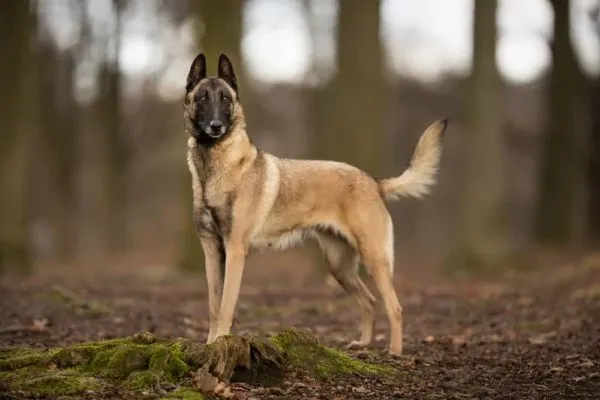
Should You Get a Belgian Malinois Puppy?
There is another facet to training a Belgian Malinois dog to consider.
There is no puppy in the world that is not very cute. Belgian Malinois puppies are very, very cute! It is easy to get sucked in by a cuddly puppy without realizing what is yet to come.
All puppies require a lot of devotion, dedication, time, and training to acclimate successfully to life in a family and community. But Belgian Malinois puppies double or even triple the time commitment.
This is because your Belgian Malinois puppy will need to learn all those basics – potty training, house training, basic commands, etc – plus learn how to manage their intensely strong prey and chase drive and protective instincts – all at the same time.
There is the potential to reduce some of that workload when you choose to rescue or adopt an adult Belgian Malinois dog instead.
As the American Belgian Malinois Rescue charity points out, there are many Belgian Malinois dogs that are in need of a new forever home.
Far too many owners purchase Belgian Malinois puppies and do not realize they lack the time, interest, and ability to train and care for these working dogs. So the dog gets relinquished to a charity or shelter or picked up by animal control and rehomed.
If you work with a high-quality Belgian Malinois rescue organization, you will be able to learn useful information about your adopted Mal’s past and history, any problem behaviors that need work, and any health issues that need special attention.
Often, you will also get extra assistance with basic veterinary care, basic dog training assurance, and recommendations for K-9 training programs or athletic programs.
This way, you avoid all of the special issues that only occur in puppyhood and also give a rescued Belgian Malinois a new forever home.
What Do Belgian Malinois Dogs Learn in K-9 Training?
Now that you understand the potential workload you will face if you decide to choose a Belgian Malinois for your protection dog, you might be wondering exactly what skills your dog will learn in a professional K-9 protection dog program.
The actual curriculum can vary from one program to the next, so you will want to make sure the training facility is very experienced at working with the Belgian Malinois breed specifically.
But here is a general outline from Gold Coast K9 of a typical K-9 protection dog course so you can get an idea of what to expect based on the level of training desired.
Basic individual/family protection dog training
- Socialized with strange people
- Stays calm in the presence of loud noises (like fireworks)
- Potty trained
- Kennel and house trained (will lie down in designated spot on command)
- Agility skills (jumping, climbing, tunnels, running)
- Will bark/be silent on command
- Trained to search and protect you against a variety of threats
In addition to these basic skills, many K-9 training programs offer additional customized training programs.
These can include any/all of the following:
- Vehicle, airplane, helicopter training
- Socialized to livestock, other family pets, and strange animals
- Tracking, perimeter, and home search, nose work
- Pursuit and recall
- Use the bathroom on command
- Handler training for special situations
All of these and more specialized training programs can help your Belgian Malinois learn how to successfully navigate diverse types of triggers and situations that may fit your specific situation.
If you are interested in hunting or tracking with your Belgian Malinois, you can also enroll in programs to teach you both how to work together as a team in these types of activities.
Preparing to Own and Train a Belgian Malinois
The time to plan and prepare for training and cost calculations of a Belgian Malinois puppy or adult dog is not when you first bring your new dog home to stay.
For the best results, you want to do the legwork of finding out what local K-9 training resources are available before you make the commitment to a new puppy or adult dog.
FAQ:
1. What kind of jobs are Belgian Malinois dogs commonly trained for?
Answer: Belgian Malinois dogs are a popular pick for K-9 military, police, and security jobs worldwide.
2. Can Belgian Malinois dogs make good pets?
Answer: They can make good pets only with special training and several hours per day of high-intensity activity, exercise, and play.
3. What kind of training does a Belgian Malinois need?
Answer: Belgian Malinois dogs need two kinds of training: basic commands and specialized training for protection and guard dog breeds, to distinguish between friends and potential threats.
4. What is the history of the Belgian Malinois breed?
Answer: Belgian Malinois is one of four closely related Belgian Shepherd dog breeds. All four breeds have very high herding, guarding, protecting, and prey drive. They have always worked hard at a difficult job on a daily basis, day in, and day out.
5. How can one prepare for owning and training a Belgian Malinois?
Answer: One should evaluate their lifestyle and time availability to see if they even have the time to commit to this high-intensity dog breed. One should invest in learning how to train a Belgian Malinois and find a local canine athletics group to join with their dog. One can also enroll their dog in specialized K-9 training programs. It is advisable to plan and prepare for training and cost calculations before making the commitment to a new Belgian Malinois puppy or adult dog.
























